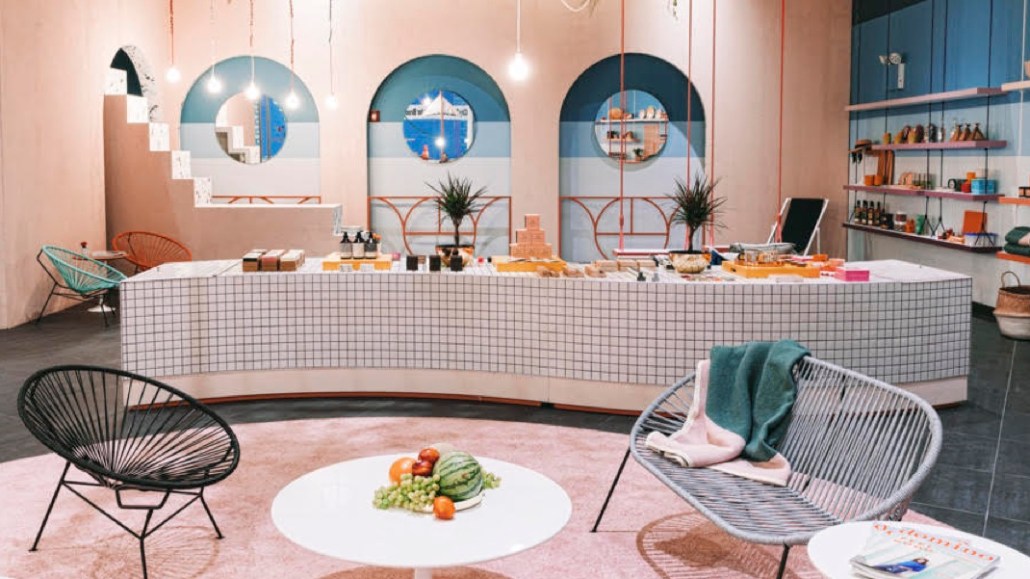Save 50% on a 3-month Digiday+ membership. Ends Dec 5.
‘It’s a crowded landscape’: Why some publishers have abandoned holiday pop-ups

The holiday pop-up has been a recent favorite for publishers, serving as a way to combine commerce and sponsorship revenues. But this year, several publishers aren’t keeping up the tradition.
The Strategist, Domino and Thrillist all previously operated temporary holiday stores, some for several years in a row. But with fewer brands wanting to pay up, these publishers have scrapped such activations this year. Domino’s editor-in-chief, Jessica Romm Perez, said her publication won’t have any holiday pop-up shops or commerce-based activations for a few reasons, in part because there are so many holiday pop-up stores.
“It’s just gotten so hard to stand out in terms of holiday pop-ups,” said Romm Perez. “It’s a crowded landscape.”
Last year, The Strategist launched a pop-up shop for eight weeks in the SoHo neighborhood of New York City. This year, it is opting instead to put its marketing resources behind its e-commerce business. The product recommendation site ran a brand marketing campaign from late September to early this month, aimed at driving readers to its online gift guides. The site also focused on regions outside New York, running out-of-home ads and campaigns in Chicago and London.
Thrillist also used to stage an annual holiday pop-up in Manhattan. Called Holiday Hideaway, it featured more than 40 vendors in a craft fair arrangement. But this year the publisher is skipping the pop-up, saying it will instead direct resources into the 100 Course Meal, a new series of quarterly events focused on Los Angeles-based cuisine and without ties to the holiday season.
Last year’s pop-up shop for The Strategist prompted New York Media to experiment with in-person activations, said Camilla Cho, who at the time was the company’s gm of e-commerce. She now serves as svp of e-commerce for Vox Media, which merged with the New York publisher.
“We would be happy to do it again if the appropriate opportunity came up,” Cho said. “And [we] have a have a lot of ideas for [real-life] activations in the pipeline.”
Ad position: web_incontent_pos1
Todd Krizelman, CEO and founder of MediaRadar, said the transactional aspect of a holiday commerce pop-up is “powerful for the media company to show that not only can they authenticate the audience but [that audience] will also show up and buy something.”
Based on MediaRadar’s research, Krizelman said it is very hard for publishers that are trying to earn consumer revenue during the holidays to secure a profit from e-commerce-only initiatives. And unlike a traditional retail operation, which has distribution and logistics efficiencies in place, a publication taking on these overhead costs might not have the in-house resources to profitably operate an online-only store or realize a return on the investment.
Regardless of duration or location, bringing a pop-up to life costs at least $100,000, said Eric Fleming, co-founder and executive producer of experiential marketing agency Makeout. Sponsorships are critical to cover these costs.
“I’m not seeing a reduction in experiential spending,” said AMP’s svp of client services, Scott Lennard, who leads the advertising agency’s experiential division. “But the bar has been raised, and the experiences are getting richer.”
For the past three years, Domino consistently run activations during the holiday season. Two years ago, the shelter publisher opened a 3,000-square-foot pop-up store, also in SoHo, sponsored by Home Depot in advance of the holiday season. And last year it worked with Amazon to host a lounge space in a Manhattan loft with curated products that attendees could purchase by scanning codes with their phones.
Ad position: web_incontent_pos2
These days, Romm Perez said, instead of stores, sponsors want more high-touch events that include content that will resonate deeply with audiences, such as panels or talks, versus singular pop-up shops.
For example, this fall Domino promoted Amazon’s wedding registry by rolling out just for a weekend a pop-up store tied to Domino magazine’s first wedding-specific issue.
“Experiential used to mean more pop-ups,” Romm Perez said. “Now it’s trending toward something more meaningful with content integrations.”
More in Media

Digiday+ Research Subscription Index 2025: Subscription strategies from Bloomberg, The New York Times, Vox and others
Digiday’s third annual Subscription Index examines and measures publishers’ subscription strategies to identify common approaches and key tactics among Bloomberg, The New York Times, Vox and others.

From lawsuits to lobbying: How publishers are fighting AI
We may be closing out 2025, but publishers aren’t retreating from the battle of AI search — some are escalating it, and they expect the fight to stretch deep into 2026.

Media Briefing: Publishers turn to vertical video to compete with creators and grow ad revenue in 2026
Publishers add vertical video feeds to their sites to boost engagement, attract video ad spend and compete with news creators.
Ad position: web_bfu



